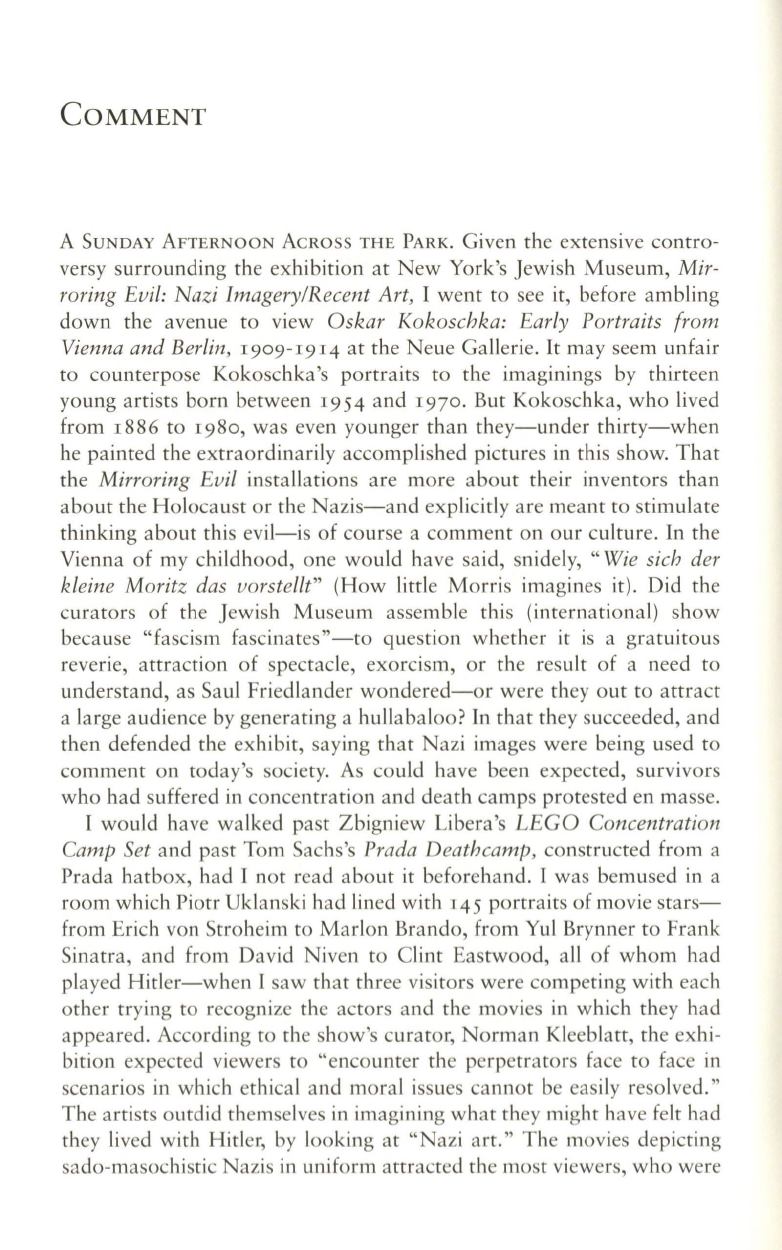
COMMENT
A SUNDAY AFTERNOON ACROSS THE PARK. Given the extensive contro–
versy surrounding the exhibition at New York's Jewish Museum,
Mir–
roring Evil: Nazi Imagery/Recent Art,
I went to see it, before ambling
down the avenue to view
Oskar Kokoschka: Early Portraits from
Vienna and Berlin,
1909-1914
at the Neue Gallerie. It may seem unfair
to counterpose Kokoschka's portraits to the imaginings by thirteen
young artists born between
1954
and
1970.
But Kokoschka, who lived
from
1886
to
1980,
was even younger than they-under thirty-when
he painted the extraordinarily accomplished pictures in this show. That
the
Mirroring Evil
installations are more about their inventors than
about the Holocaust or the Nazis-and explicitly are meant to stimulate
thinking about this evil-is of course a comment on our culture. In the
Vienna of my childhood, one would have said, snidely,
"Wie sich der
kleine Moritz das vorstellt"
(How little Morris imagines it). Did the
curators of the Jewish Museum assemble this (international) show
because "fascism fascinates"-to question whether it is a gratuitous
reverie, attraction of spectacle, exorcism, or the result of a need to
understand, as Saul Friedlander wondered-or were they out to attract
a large audience by generating a hullabaloo? In that they succeeded, and
then defended the exhibit, saying that Nazi images were being used to
comment on today's society. As could have been expected, survivors
who had suffered in concentration and death camps protested en masse.
I would have walked past Zbigniew Libera's
LEGO Concentration
Camp Set
and past Tom Sachs's
Prada Deathcamp,
constructed from a
Prada hatbox, had I not read about it beforehand. I was bemused in a
room which Piotr Uklanski had lined with
145
portraits of movie stars–
from Erich von Stroheim to Marlon Brando, from Yul Brynner to Frank
Sinatra, and from David Niven to Clint Eastwood, all of whom had
played Hitler-when I saw that three visitors were competing with each
other trying to recognize the actors and the movies in which they had
appeared. According to the show's curator, Norman Kleeblatt, the exhi–
bition expected viewers to "encounter the perpetrators face to face in
scenarios in which ethical and moral issues cannot be easily resolved."
The artists outdid themselves in imagining what they might have felt had
they lived with Hitler, by looking at "Nazi art." The movies depicting
sado-masochistic Nazis in uniform attracted the most viewers, who were


